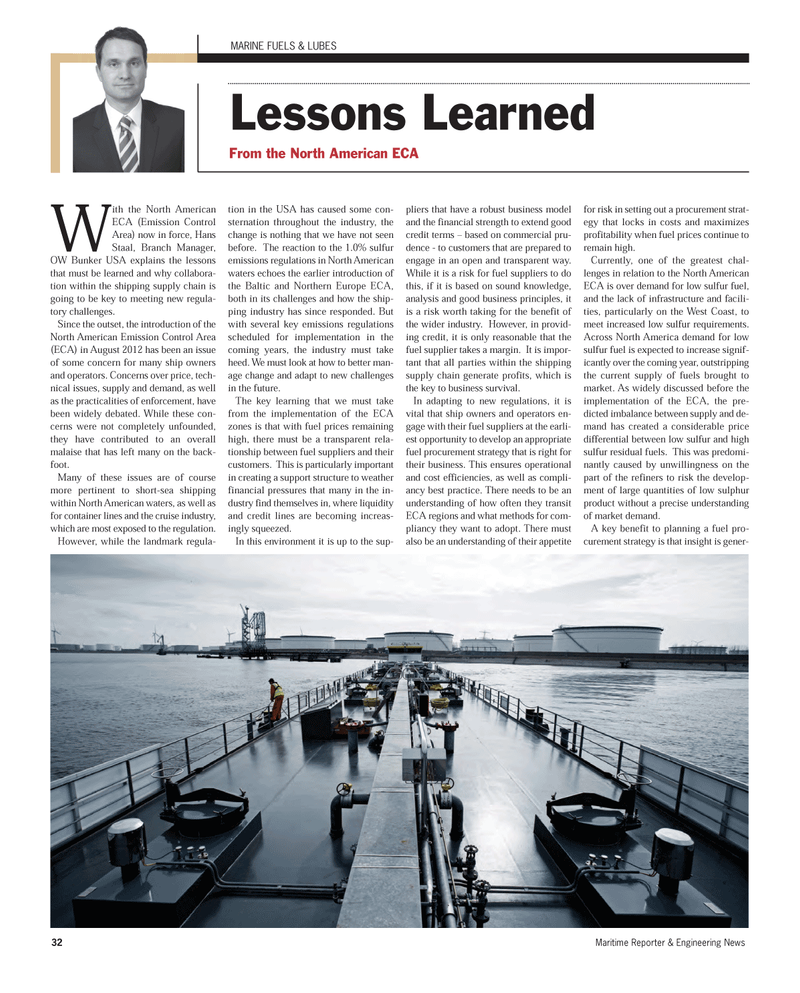
Page 32: of Maritime Reporter Magazine (November 2012)
Workboat Annual
Read this page in Pdf, Flash or Html5 edition of November 2012 Maritime Reporter Magazine
32Maritime Reporter & Engineering News With the North American ECA (Emission ControlArea) now in force, Hans Staal, Branch Manager, OW Bunker USA explains the lessons that must be learned and why collabora- tion within the shipping supply chain isgoing to be key to meeting new regula- tory challenges. Since the outset, the introduction of theNorth American Emission Control Area (ECA) in August 2012 has been an issue of some concern for many ship owners and operators. Concerns over price, tech- nical issues, supply and demand, as wellas the practicalities of enforcement, have been widely debated. While these con- cerns were not completely unfounded,they have contributed to an overall malaise that has left many on the back- foot.Many of these issues are of course more pertinent to short-sea shippingwithin North American waters, as well as for container lines and the cruise industry, which are most exposed to the regulation. However, while the landmark regula- tion in the USA has caused some con-sternation throughout the industry, the change is nothing that we have not seen before. The reaction to the 1.0% sulfur emissions regulations in North American waters echoes the earlier introduction of the Baltic and Northern Europe ECA,both in its challenges and how the ship- ping industry has since responded. Butwith several key emissions regulations scheduled for implementation in thecoming years, the industry must take heed. We must look at how to better man- age change and adapt to new challenges in the future.The key learning that we must take from the implementation of the ECAzones is that with fuel prices remaininghigh, there must be a transparent rela-tionship between fuel suppliers and theircustomers. This is particularly important in creating a support structure to weatherfinancial pressures that many in the in- dustry find themselves in, where liquidity and credit lines are becoming increas-ingly squeezed. In this environment it is up to the sup- pliers that have a robust business model and the financial strength to extend good credit terms ? based on commercial pru-dence - to customers that are prepared toengage in an open and transparent way. While it is a risk for fuel suppliers to dothis, if it is based on sound knowledge, analysis and good business principles, it is a risk worth taking for the benefit of the wider industry. However, in provid- ing credit, it is only reasonable that thefuel supplier takes a margin. It is impor- tant that all parties within the shippingsupply chain generate profits, which is the key to business survival. In adapting to new regulations, it is vital that ship owners and operators en- gage with their fuel suppliers at the earli- est opportunity to develop an appropriate fuel procurement strategy that is right for their business. This ensures operational and cost efficiencies, as well as compli- ancy best practice. There needs to be an understanding of how often they transit ECA regions and what methods for com- pliancy they want to adopt. There must also be an understanding of their appetitefor risk in setting out a procurement strat-egy that locks in costs and maximizes profitability when fuel prices continue to remain high. Currently, one of the greatest chal- lenges in relation to the North American ECA is over demand for low sulfur fuel, and the lack of infrastructure and facili- ties, particularly on the West Coast, to meet increased low sulfur requirements. Across North America demand for low sulfur fuel is expected to increase signif- icantly over the coming year, outstripping the current supply of fuels brought tomarket. As widely discussed before the implementation of the ECA, the pre-dicted imbalance between supply and de-mand has created a considerable pricedifferential between low sulfur and high sulfur residual fuels. This was predomi- nantly caused by unwillingness on thepart of the refiners to risk the develop- ment of large quantities of low sulphur product without a precise understandingof market demand. A key benefit to planning a fuel pro- curement strategy is that insight is gener- MARINE FUELS & LUBESLessons LearnedFrom the North American ECA MR#11 (26-33):MR Template 10/22/2012 3:27 PM Page 32

 31
31

 33
33
